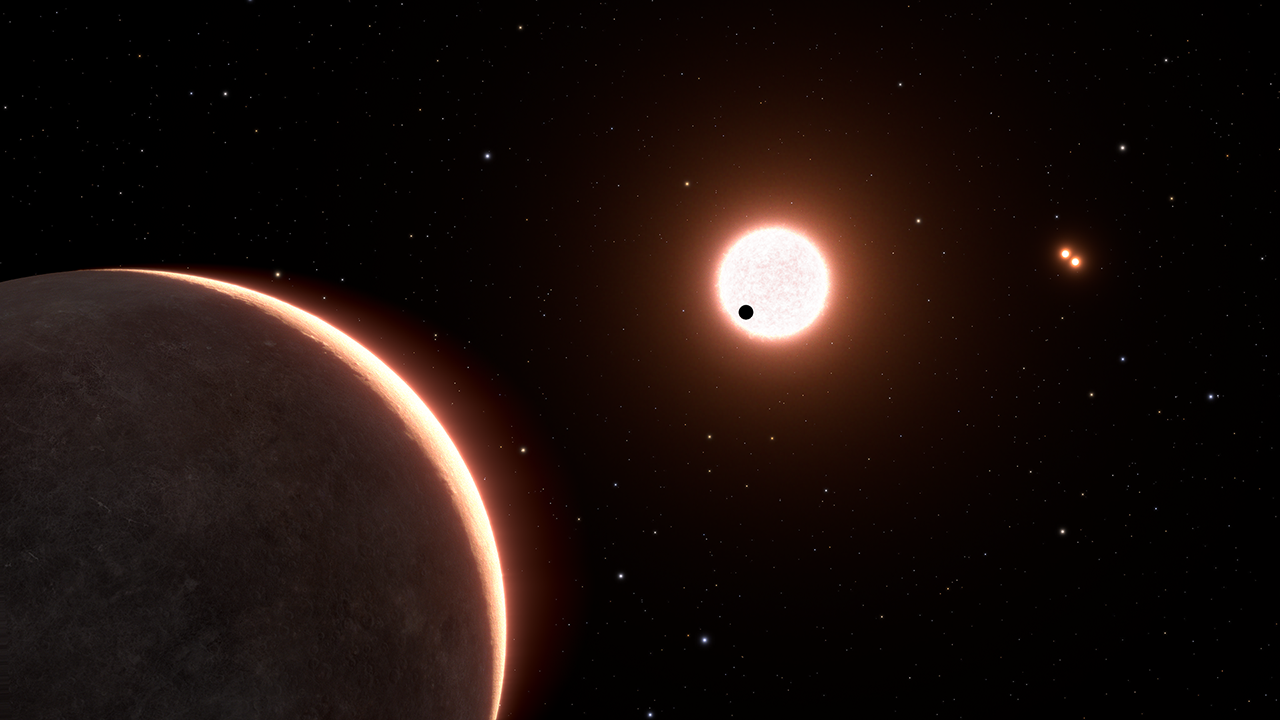Hubble Telescope investigates nearby exoplanet, finds it's Earth-size
This alien world will make an ideal target for follow-up studies of its atmosphere — if it has one.

The Hubble Space Telescope has measured the diameter of the nearest transiting exoplanet to us, discovering that it is a rocky planet very similar in size to Earth. Unfortunately, however, the world's surface is far too hot to support liquid water or life as we know it.
The planet, known as LTT 1445Ac, was first discovered in 2022 by NASA’s Transiting Exoplanet Survey Satellite (TESS). LTT 1445Ac orbits a cool M-dwarf star that is just a quarter of the mass of our sun; the star itself is found in a triple system of M-dwarfs located 22.5 light years away in the direction of the constellation of Eridanus, the River. LTT 1445Ac is joined by two other planets in the triplet, LTT 1445Ab and LTT1445Ad, both of which orbit farther out.
Although there are numerous exoplanets that are closer to us, LTT 1445Ac is the closest that actually transits, or moves in front of, its star. When a planet makes such a transit, it blocks some of its star’s light — the bigger the planet, the more light it blocks.
Related: Hubble telescope sees an angry star and an evaporating planet
TESS discovered LTT 1445Ac by measuring this dip in light, but there was a problem. Scientists are very fortunate when they get to observe a transit, as these events can only be noticed in those cases where our line of sight is well-aligned with the planet's orbital plane around its star. Even a slight misalignment can deem a planet's transit unseen. In the case of LTT 1445Ac, TESS was not able to distinguish whether the alignment meant the entirety of the planet was transiting its star, or if it was just a "grazing transit". A grazing transit would mean the planet merely appeared to clip the edge of the star, exhibiting only a partial transit. If this were the case, it would suggest a misleading value for the size of the planet.
"There was a chance that this system has an unlucky geometry and if that's the case, we wouldn’t measure the right size," Emily Pass of the Harvard–Smithsonian Center for Astrophysics, who led the Hubble observations, said in a statement. "But with Hubble’s capabilities, we nailed it."
The Hubble Space Telescope was able to confirm that the whole of the planet indeed transits the star, and that the diameter of the planet is just about 1.07 times larger than Earth.
Breaking space news, the latest updates on rocket launches, skywatching events and more!
Previously, the ESPRESSO (Echelle Spectrograph for Rocky Exoplanets and Stable Spectroscopic Observations) instrument on the European Southern Observatory’s Very Large Telescope in Chile had measured the radial velocity of the system. Radial velocity is a measure of how much a star appears to "wobble" as it moves around a shared center of mass with an orbiting planet. The more massive the planet, the larger the wobble; ESPRESSO measured the mass of LTT 1445Ac to be 1.37 times the mass of Earth.
Knowing its radius and its mass, it was then a simple matter to calculate LTT 1445Ac’s density, which came out to 5.9 grams per cubic centimeter. Earth, by comparison, has an average density of 5.51 grams per cubic centimeter. All in all, LTT 1445Ac is a little larger, a little denser and somewhat more massive than our planet, with a surface gravity 1.37 times greater than on Earth (a surface gravitational acceleration of 13.4 meters per second squared compared to Earth's 9.8 meters per second squared).
Alas, orbiting its star at a distance of 3.98 million kilometers (2.47 million miles/0.02659AU) every 3.12 days, LTT 1445Ac is too hot for liquid water, with a surface temperature of approximately 260 degrees Celsius (500 degrees Fahrenheit). Life as we know it cannot survive without liquid water, so LTT 1445Ac’s scorching hot surface is probably lifeless (unless a form of biology unbeknownst to us manages to thrive in such unrelenting heat.)
Planet b in the system, a super-Earth also seen to transit, appears to be inhospitable as well, though the omens might be more positive for planet d. D is a rocky planet within the star’s habitable zone, but unfortunately it does not transit, and therefore astronomers are unable to study its atmosphere to figure out whether it hosts habitable conditions.
Astronomers study exoplanetary atmospheres during transits using a technique called transmission spectroscopy. As a planet moves in front of its star as seen from our vantage point, its atmosphere (if it has one) can absorb some of the starlight, with different molecules absorbing at different wavelengths, revealing their presence.
It is currently a mystery as to whether LTT 1445Ac has an atmosphere, but being the closest known transiting planet (alongside its sibling planet b) makes it a prime target for spectroscopic follow-up studies with both Hubble and the James Webb Space Telescope (JWST). The next closest known transiting exoplanet is Gliese 486b, located 26.4 light years away. The JWST observed 486b’s atmosphere earlier in 2023, detecting possible signs of water vapor.
TESS was designed to find transiting exoplanets around the brightest stars in the sky, which also tend to be among the closest. Their proximity to us makes spectroscopic follow-up studies of their atmospheres way easier.
If LTT 1445Ac is anything to go by, TESS is succeeding in its mission.
The discovery was reported in September in The Astronomical Journal.

Keith Cooper is a freelance science journalist and editor in the United Kingdom, and has a degree in physics and astrophysics from the University of Manchester. He's the author of "The Contact Paradox: Challenging Our Assumptions in the Search for Extraterrestrial Intelligence" (Bloomsbury Sigma, 2020) and has written articles on astronomy, space, physics and astrobiology for a multitude of magazines and websites.

